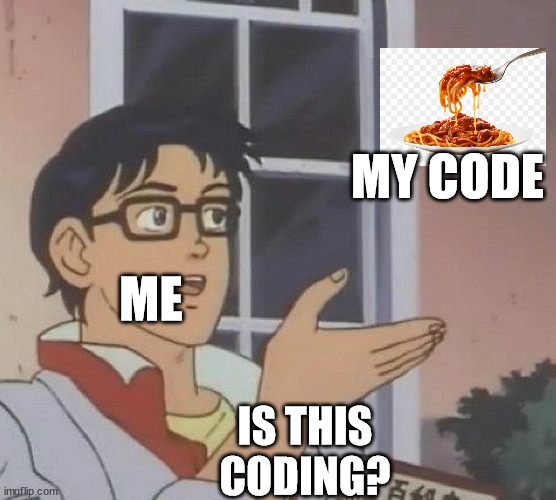294
you are viewing a single comment's thread
view the rest of the comments
view the rest of the comments
this post was submitted on 12 Sep 2024
294 points (96.2% liked)
Programmer Humor
19965 readers
597 users here now
Welcome to Programmer Humor!
This is a place where you can post jokes, memes, humor, etc. related to programming!
For sharing awful code theres also Programming Horror.
Rules
- Keep content in english
- No advertisements
- Posts must be related to programming or programmer topics
founded 2 years ago
MODERATORS

I'm an amateur I'm not sure what inheritance is:X? Is it like instantiateing?
When you start learning about different paradigms, you'll likely learn much more about inheritance when learning about the Object Oriented design paradigm.
To overly simplify, you create objects that inherit attributes from other objects. It's for instance a way to create reusable patterns, that have stronger and more reliable data structures.
I made the joke comment, because for instance, you could create a
Turtleclass, and always know it was aTurtle. Again, an oversimplification.EDIT: I should also add that for some reason OOP is an oddly divisive subject. Developers always seem to want to argue about it.
At this point I think there is no software dev topic that is somehow not devisive.
Now I want to try something:
"Boolean variables don't suck."
No one uses Boolean values anyway and with the amount of resources available on modern systems we can just replace them with integers and we should be fine. This also makes it easier to teach people, as they would learn less different data types.
Yes I'm a software dev :)
I love it!
Oh yea, class resources. That would work! Thanks.im going to have to into this more, as it's going to be useful
Just keep in mind that inheritance is nowadays a very contested feature. Even most people still invested in object oriented programming recognise that in hindsight inheritance was mostly a mistake. The industry as a whole is also making a shift to move more towards functional programming, in which object orientation as a whole is taking more of a backseat and inheritance specifically is not even supported anymore. So yeah, take the chance to learn, but be cautious before going into any one direction too deeply.
I like to mix between OOP and FP for different levels. OOP is great for higher architectural problems. FP is great for everything under it.
And yes, inheritance was a huge mistake. Just use composition and interfaces instead.
Yeah, I mix them too, although I apply quite a bit of functional techniques especially at the architectural level as well. OO I use mostly for dealing with I/O and other areas where statefulness cannot be avoided.
If you’re interested, I also wrote an in-depth blog where I touch on these topics: https://arendjr.nl/blog/2024/07/post-architecture-premature-abstraction-is-the-root-of-all-evil/
If I could give a suggestion I wish I had gotten much earlier on in my education and career, it would be to really spend some time learning about the different paradigms, and their best use cases. You will likely ensure yourself a strong foundation in software architecture.
I'll check it out! I'm very casual and doing thus mostly as a passion/Fun project. But I love any direction thank you:)
Inheritance established "is a" relationship between classes.
Underlying classes hold an inner object to the super class, everything from Turtle will be in TigerTurtle and BossTurtle.
In some languages that is configurable with public, private, protected keywords.
Relatedly, there's also composition, which establishes a "has a" relationship:
Since Turtle is NOT a tail, but a whole animal, turtle should not inherit TurtleTail. But it HAS a tail, thus we add turtle tail as a property.
I'm only commenting because the actual python is practically pseudo code:
It is simpler than my faulty memory remembers, time to learn python again 😁